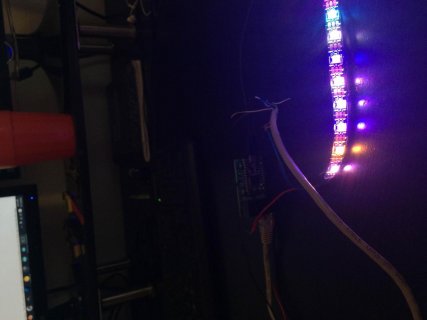Hi,
I have a 4 meter long strip of 60 leds/meter 2812 Leds. I tested the strip with the Adafruit Neopixel Library, a power supply and an Arduino Uno.
Everything worked the way it should so I know the LED strip and power supply work correctly.
I want to switch to using the OctoWS2811 library but I am having problems.
I am using the OctoWS2811 Adaptor and have wired / followed the directions here: https://www.pjrc.com/store/octo28_adaptor.html
However, for some reason when I try the BasicTest example, only about half the LEDs turn on, (sometimes only 8 turn on if I specify ledsPerStrip as the default 120 in the sketch) and when they turn on they are basically all white with a little bit of tweaking out.
Has anyone else experienced this problem?
The only parts I was not sure about in the instructions are the use of the phrase :
- "Top/Bottom RJ-45 Jack". The RJ-45 jacks are next to each other so I am not sure if this means left or right (when looking at the at the end of the board with RJ 45 jacks). Regardless it didn't make a difference. When plugged into the Left jack, nothing happens. In the Right jack at least there is some change in the leds.
- "The LED power supply ground and Teensy signal ground should meet at or near the LED strip signal inputs" - I am not sure exactly what this means either.
My set up is:
I have the V- from the Power supply going to the GND pin hole on the Adapter board.
I have the V+ going to the +5V input pad on the LED strip
I have the Orange wire from CAT6 connected to the DIN pad on the LED strip
I have the Orange and White wire from CAT 6 connected to the GND pad on the LED strip
I have the Teensy plugged in via USB to my computer
All wires are fairly short so the power supply and teensy and led strip are all close together.
Can anyone spot potential problems?
Here is a photo that kind of shows my issue.

(Just imagine there is no movement of any kind except some flickering)
I have a 4 meter long strip of 60 leds/meter 2812 Leds. I tested the strip with the Adafruit Neopixel Library, a power supply and an Arduino Uno.
Everything worked the way it should so I know the LED strip and power supply work correctly.
I want to switch to using the OctoWS2811 library but I am having problems.
I am using the OctoWS2811 Adaptor and have wired / followed the directions here: https://www.pjrc.com/store/octo28_adaptor.html
However, for some reason when I try the BasicTest example, only about half the LEDs turn on, (sometimes only 8 turn on if I specify ledsPerStrip as the default 120 in the sketch) and when they turn on they are basically all white with a little bit of tweaking out.
Has anyone else experienced this problem?
The only parts I was not sure about in the instructions are the use of the phrase :
- "Top/Bottom RJ-45 Jack". The RJ-45 jacks are next to each other so I am not sure if this means left or right (when looking at the at the end of the board with RJ 45 jacks). Regardless it didn't make a difference. When plugged into the Left jack, nothing happens. In the Right jack at least there is some change in the leds.
- "The LED power supply ground and Teensy signal ground should meet at or near the LED strip signal inputs" - I am not sure exactly what this means either.
My set up is:
I have the V- from the Power supply going to the GND pin hole on the Adapter board.
I have the V+ going to the +5V input pad on the LED strip
I have the Orange wire from CAT6 connected to the DIN pad on the LED strip
I have the Orange and White wire from CAT 6 connected to the GND pad on the LED strip
I have the Teensy plugged in via USB to my computer
All wires are fairly short so the power supply and teensy and led strip are all close together.
Can anyone spot potential problems?
Here is a photo that kind of shows my issue.

(Just imagine there is no movement of any kind except some flickering)


